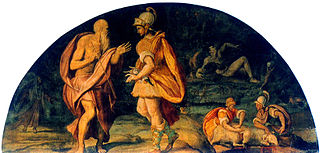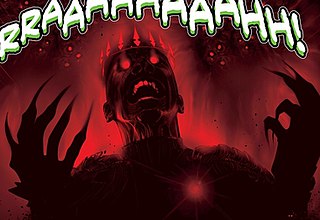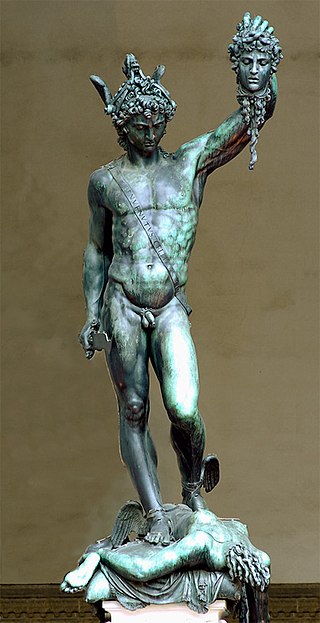
In ancient Greek religion and mythology, Demeter is the Olympian goddess of the harvest and agriculture, presiding over crops, grains, food, and the fertility of the earth. Although Demeter is mostly known as a grain goddess, she also appeared as a goddess of health, birth, and marriage, and had connections to the Underworld. She is also called Deo. In Greek tradition, Demeter is the second child of the Titans Rhea and Cronus, and sister to Hestia, Hera, Hades, Poseidon, and Zeus. Like her other siblings except Zeus, she was swallowed by her father as an infant and rescued by Zeus.

Hades, in the ancient Greek religion and mythology, is the god of the dead and the king of the underworld, with which his name became synonymous. Hades was the eldest son of Cronus and Rhea, although this also made him the last son to be regurgitated by his father. He and his brothers, Zeus and Poseidon, defeated their father's generation of gods, the Titans, and claimed joint rulership over the cosmos. Hades received the underworld, Zeus the sky, and Poseidon the sea, with the solid earth available to all three concurrently. In artistic depictions, Hades is typically portrayed holding a bident and wearing his helm with Cerberus, the three-headed guard-dog of the underworld, standing at his side.

In ancient Greek mythology and religion, Persephone, also called Kore or Cora, is the daughter of Zeus and Demeter. She became the queen of the underworld after her abduction by her uncle Hades, the king of the underworld, who would later also take her into marriage.

Proserpina or Proserpine is an ancient Roman goddess whose iconography, functions and myths are virtually identical to those of Greek Persephone. Proserpina replaced or was combined with the ancient Roman fertility goddess Libera, whose principal cult was housed in the Aventine temple of the grain-goddess Ceres, along with the wine god Liber.

A taboo, also spelled tabu, is a social group's ban, prohibition, or avoidance of something based on the group's sense that it is excessively repulsive, offensive, sacred, or allowed only for certain people. Such prohibitions are present in virtually all societies. Taboos may be prohibited explicitly, for example within a legal system or religion, or implicitly, for example by social norms or conventions followed by a particular culture or organization.

In ancient Greek religion and Greek mythology, Minthe is an Underworld Naiad nymph associated with the river Cocytus. She was beloved by Hades, the King of the Underworld, and became his mistress. But she was transformed into a mint plant by either his wife Persephone or her mother Demeter. The plant was also called by some as hedyosmos, which means "sweet-smelling".

In ancient Greek religion and mythology, Pluto was the ruler of the Greek underworld. The earlier name for the god was Hades, which became more common as the name of the underworld itself. Pluto represents a more positive concept of the god who presides over the afterlife. Ploutōn was frequently conflated with Ploûtos, the Greek god of wealth, because mineral wealth was found underground, and because as a chthonic god Pluto ruled the deep earth that contained the seeds necessary for a bountiful harvest. The name Ploutōn came into widespread usage with the Eleusinian Mysteries, in which Pluto was venerated as both a stern ruler and a loving husband to Persephone. The couple received souls in the afterlife and are invoked together in religious inscriptions, being referred to as Plouton and as Kore respectively. Hades, by contrast, had few temples and religious practices associated with him, and he is portrayed as the dark and violent abductor of Persephone.

Mother Nature is a personification of nature that focuses on the life-giving and nurturing aspects of nature by embodying it, in the form of a mother or mother goddess.

A katabasis or catabasis is a journey to the underworld. Its original sense is usually associated with Greek mythology and Classical mythology more broadly, where the protagonist visits the Greek underworld, also known as Hades. The term is also used in a broad sense of any journey to the realm of the dead in other mythological and religious traditions. A katabasis is similar to a nekyia or necromancy, where one experiences a vision of the underworld or its inhabitants; a nekyia does not generally involve a physical visit, however. One of the most famous examples is that of Odysseus, who performs something on the border of a nekyia and a katabasis in book 11 of the Odyssey; he visits the border of the realms before calling the dead to him using a blood rite, with it being disputed whether he was at the highest realm of the underworld or the lowest edge of the living world where he performed this.
The Anthesphoria was one of the religious festivals held in Ancient Greece in honor of Persephone's return from the Underworld. According to mythological tradition, Persephone's husband, Hades, tricked her into eating four pomegranate seeds when Zeus ordered him to let her return to her mother after he had kidnapped her. Because she ate the seeds, Persephone was then forced to spend one-third of the year in the Underworld and only allotted two-thirds of the year aboveground. This festival was held in several different regions throughout the ancient world, with each one having distinct customs and rituals.

In Greek mythology, the Greek underworld, or Hades, is a distinct realm where an individual goes after death. The earliest idea of afterlife in Greek myth is that, at the moment of death, an individual's essence (psyche) is separated from the corpse and transported to the underworld. In early mythology the dead were indiscriminately grouped together and led a shadowy post-existence; however, in later mythology elements of post-mortem judgment began to emerge with good and bad people being separated.

Hades is a fictional character appearing in DC Comics publications and related media, commonly as an adversary and sometimes-ally of the superhero Wonder Woman. Based upon the eponymous Greek mythological figure, he is the Olympian god of the dead and ruler of the underworld.
Melinoë is a chthonic nymph or goddess invoked in one of the Orphic Hymns and represented as a bringer of nightmares and madness. The name "Melinoë" also appears on a metal tablet in association with Persephone. In the hymn, Melinoë has characteristics that seem similar to Hecate and the Erinyes, and Melinoë's name is sometimes thought to be an epithet of Hecate.
Persephone, the daughter of Zeus and Demeter in Greek mythology, appears in films, works of literature, and in popular culture, both as a goddess character and through the symbolic use of her name. She becomes the queen of the underworld through her abduction by Hades, the god of the underworld. The myth of her abduction represents her dual function as the as chthonic (underworld) and vegetation goddess: a personification of vegetation, which shoots forth in Spring and withdraws into the earth after harvest. Proserpina is the Roman equivalent.

In classical mythology, the Cap of Invisibility is a helmet or cap that can turn the wearer invisible, also known as the Cap of Hades or Helm of Hades. Wearers of the cap in Greek myths include Athena, the goddess of wisdom, the messenger god Hermes, and the hero Perseus. Those wearing the Cap become invisible to other supernatural entities, akin to a cloud of mist sometimes used to remain undetectable.

In Greek mythology, Ascalaphus was the son of Acheron and Orphne.

Lore Olympus is a romance webcomic created by New Zealand artist Rachel Smythe. The comic is a modern retelling of the relationship between the Greek goddess and god Persephone and Hades. It began publishing weekly on the platform Webtoon in March 2018. Lore Olympus is currently the most popular comic on Webtoon; as of March 2024, it has 1.4 billion views and 6.5 million subscribers. The comic has won two Eisner Awards, two Harvey Awards, and two Ringo Awards. It was announced in 2019 that a television adaptation was under development.
In Greek mythology, Ictinus is a minor figure who tried to violate his daughter and was transformed into a bird, in part of an aetiological myth that attempts to explain nature. His brief tale survives in the works of Dionysius Periegetes.
In Greek mythology, Side is a minor figure who tried to escape her enamored father and was transformed into a tree, in part of an aetiological myth that attempts to explain the nature of trees and birds. Her brief tale survives in the works of Dionysius Periegetes, an ancient Greek author who is believed to have been born in the city of Alexandria, and to have lived around the time of Roman Emperor Hadrian.













